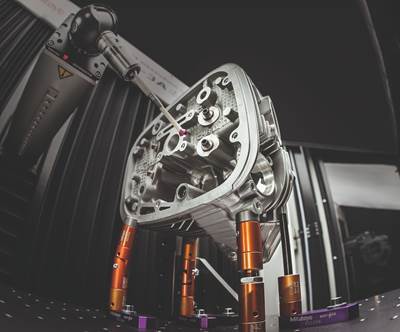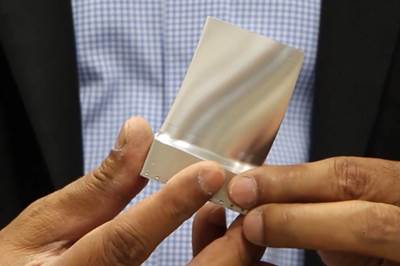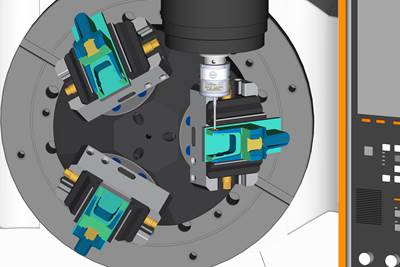Integrated CAD/CAM Promotes Process Efficiency, Traceability
High-requirement markets are not only searching for good parts — they're searching for proof of good parts. CAD/CAM software can help.
Share




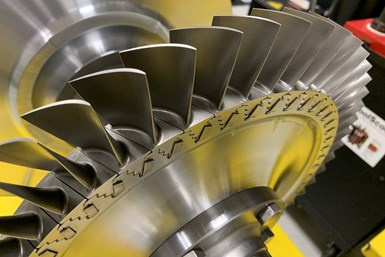
NX CAM, which is part of Siemens’ Xcelerator software and service portfolio, includes application-specific modules that simplify programming for difficult part features, such as these blisk blades. Photos courtesy of Rhinestahl Advanced Manufacturing Group
Eight machining steps deep into a high-value part is a terrible place to discover an early mistake.
Rhinestahl Advanced Manufacturing Group (AMG), a Mason, Ohio-based high-end manufacturer of parts for aerospace, defense, rail and more, no longer worries as much about this scenario. In addition to using Siemens’ NX CAM software to program, optimize and simulate CNC machining operations, Rhinestahl AMG leverages the software’s ability to maintain associativity between a “master model” and its tool paths, fixturing and production documentation. This associativity streamlines Rhinestahl’s ability to respond to engineering change orders and improves its ability to meet traceability requirements.
Simulations and Savings
Rhinestahl AMG manufactures a high mix of low-volume critical parts for defense and propulsion systems — parts both complex and challenging to program and machine. NX CAM includes application-specific modules that speed programming of these parts’ most complex features. For example, the Turbomachinery module can swiftly create tool paths for simultaneous five-axis roughing between blisk and impeller blades, and specialized finishing operations generate optimized tool paths when finishing the hub, blades and splitters.
The in-process model not only maintains user-defined relationships between features on the 3D part model, but also links the model with tool paths, inspection data and documentation.
Feature-based machining capability enables the software to automatically recognize features like pockets, holes and slots, then add the appropriate operations and tools to the machine program. Adaptive Milling pushes these tools further by employing full flute lengths in deep roughing cuts while keeping cutting forces consistent. On one five-axis part, this functionality reduced a 16-hour cycle time to three hours while improving tool life by almost 20%.
Rhinestahl AMG also credits the software’s robust simulation capabilities with helping prove out complex parts. In addition to more than 1,200 postprocessors, Siemens’ Post Hub online library provides Smart Machine Kit Solutions (SMKS) — essentially, digital twins of machine tools that include kinematic data. By combining the postprocessor, machine kinematic data and Rhinestahl’s desired control format, NX CAM can simulate the same NC code that will run machine tools on the shop floor, with full insight into potential collisions and the other errors which can plague the complex five-axis and multi-spindle, multi-channel operations Rhinestahl performs.
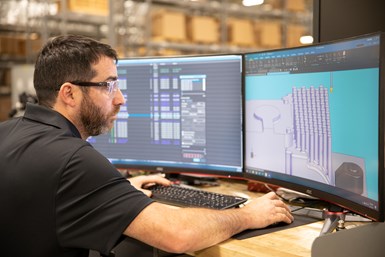
NX CAM’s in-process working model marries the 3D part model, machining steps and documentation to simplify communication between engineers, machinists and quality inspectors about part or process changes. This marriage also helps Rhinestahl AMG meet new traceability requirements.
In-Process Consistency
Engineering change orders can cause errors when changes to early process steps are not accounted for in later steps. Remodeling and revising programs for each step is workable for parts with only two or three tool paths, but many of Rhinestahl’s complex parts require eight or nine.
This additional process complexity makes NX CAM’s in-process working model a great boon to Rhinestahl. The in-process model, which Siemens also refers to as a “master model,” is like an especially detailed digital twin. The in-process model not only maintains user-defined relationships between features on the 3D part model, but also links the model with tool paths, inspection data and documentation. When Rhinestahl uses the integrated CAD module to edit the model in an early step, the software automatically revises associated features and fixturing. The CAM programmer can then regenerate the tool paths with a function in the software, which adjusts the old tool paths to account for any design changes.
These changes often relate to part design or to a decision to use a different machine due to capacity or maintenance constraints. In either case, NX CAM updates the documentation necessary for production. This includes the tool list and setup sheet, as well as 3D model drawings. By providing this up-to-date documentation, Rhinestahl AMG can prove the reliability of its parts to customers.
Traceability Through Associativity
The associativity provided by the in-process working model gives Rhinestahl a leg-up toward meeting new traceability requirements coming into favor for defense and aerospace jobs.
These requirements go beyond material traceability to require full traceability of documentation and verification of processes, says Mike Alto, Rhinestahl’s director of sales and business development. “Customers increasingly require you to control your in-process models accurately and have a formal process around that so your client can be confident when you’re making a critical part, whether it be a warhead or a submarine,” he explains.
He also says that as part of the focus on full traceability, customers in high-requirement industries are increasingly providing models or 3D PDFs instead of 2D tolerance drawings. NX CAM will come in handy here, he continues, as it can natively open a wide range of 3D model formats, removing failure points stemming from file conversion. Associativity between the in-process working model and its documentation will also minimize the risk of working from outdated documents, drastically simplifying the process of meeting traceability requirements.
The difference NX CAM is making for Rhinestahl’s traceability efforts is so extreme that Alto predicts job shops working in markets requiring full traceability will have a hard time competing without integrated CAD/CAM software that uses associative models.
Related Content
6 Machine Shop Essentials to Stay Competitive
If you want to streamline production and be competitive in the industry, you will need far more than a standard three-axis CNC mill or two-axis CNC lathe and a few measuring tools.
Read MoreOrthopedic Event Discusses Manufacturing Strategies
At the seminar, representatives from multiple companies discussed strategies for making orthopedic devices accurately and efficiently.
Read MoreCan ChatGPT Create Usable G-Code Programs?
Since its debut in late 2022, ChatGPT has been used in many situations, from writing stories to writing code, including G-code. But is it useful to shops? We asked a CAM expert for his thoughts.
Read MoreCutting Part Programming Times Through AI
CAM Assist cuts repetition from part programming — early users say it cuts tribal knowledge and could be a useful tool for training new programmers.
Read MoreRead Next
A New Quality Standard You Need to Know About
The Quality Information Framework (QIF) helps connect product data with process data in emerging data-driven environments.
Read MoreA Digital Approach to Machining Better Parts
With advanced integration of CAD/CAM, CNC and probing technology, this digital manufacturing expert demonstrates a better process for making complex airfoils without the need for special fixturing.
Read MoreSimulation Gets Real
Capability to generate something close to a true digital twin can significantly improve confidence in CAM program prove-outs.
Read More




























